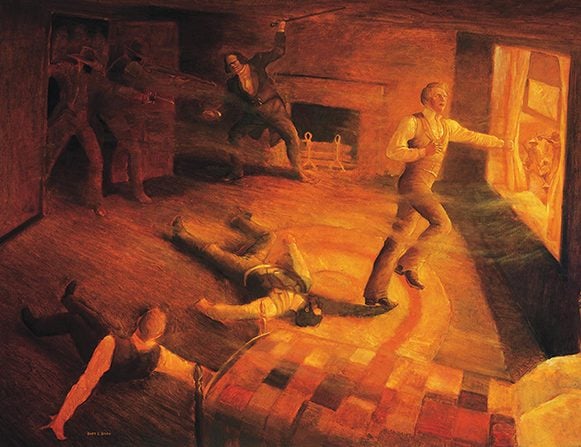
(LDS Media Library)
***
Witnesses had quite strong numbers at the box office over the past weekend. This is encouraging, and such figures are extremely important — they’re vital, in fact — for keeping the film in theaters. We’re deeply grateful for the support of those who have attended showings, just as we are for those who contributed to the movie’s creation in the first place. And, if I may say so, tonight is Family Night. And, in many places, tomorrow is five-dollar Tuesday, or something of that sort. Hint hint!
We hope that at least some of you will also consider taking your non-member friends or less-active family members. We’ve always known that the core, sustaining audience for Witnesses would be believing members of the Church of Jesus Christ of Latter-day Saints, but our hope was and is that others — non-members, lapsed members, wavering members, investigators — will also see the film. We hope that it will launch conversations and create questions. In fact, I’ve found myself wondering whether the Sunday theater box office figures for the film, which have, quite unsurprisingly (given Latter-day Saint beliefs about Sabbath observance), been much, much lower than the figures for any other day of the week, might reflect exactly those people. I hope so!
This coming Sunday, 27 June 2021, will mark the 177th anniversary of the murder of the Prophet Joseph Smith by an anti-Mormon mob in Carthage, Illinois. I don’t mean this to sound crassly commercial — please remember that I won’t make a nickel from whatever you choose to do — but this week would be a very good time to remember the Prophet and the earliest days of the Restoration by attending a screening of Witnesses. Furthermore, Monday, 28 June 2021 — a week from today — would also be a phenomenally appropriate day on which to watch Witnesses, and not only because it will be Family Night. Pretty much unanimously, the historical sources and treatments that we possess put the experience of the Three Witnesses with the angel, the plates, and the voice of God toward the end of June 1829. By far the most common date given, though, is none other than 28 June 1829. What a great day next Monday will be to recall that important event, either by simply attending a regular showing of Witnesses or by organizing a private screening for a family or neighborhood or Church group. (See witnessesfilm.com for places where the film is showing or where screenings can be organized.)
***
I would also like to call your attention to a series of free virtual firesides that will commence this coming Sunday, 27 June 2021 — making it, in other words, an unusually appropriate opportunity to reflect on the life and contributions (and the sacrifice) of the founding prophet of this dispensation:
““A Life Lived in Crescendo”: Selected Punctuation Marks of Joseph Smith’s Final Years”
And, while I’m at it, I also want to note that videos of the presentations from our recent conference on the Book of Moses are now available on the website of the Interpreter Foundation, at no charge:
“Tracing Ancient Threads in the Book of Moses”
By the way, my saying that these virtual firesides and these videos have been made available “at no charge” does not imply that they have been made available at no expense. Contributions to meet our ongoing costs, whether large or small, are both tax-exempt (in the United States, anyway) and very welcome. See Donating to the Interpreter Foundation.
***
Also available at no charge (though not at no cost) are these articles (written by unpaid authors) from a previous number of Interpreter: A Journal of Latter-day Saint Faith and Scholarship:
Daniel C. Peterson, “The Word and the Kingdom”
Abstract: Members of the Church have been charged since ancient times with the covenant need to share the Gospel message with those around them. In more recent times, this has been described as a need for “every member” to be a missionary. There are many ways that we can do so through the use of modern technology and the dedication of our talents. The “ministry of the word” beckons each of us onward.
Jeff Lindsay, “The Possibility of Janus Parallelism in the Book of Mormon”
Abstract: Janus parallelism, a tool evident in ancient Hebrew poetry, is documented at some length by Scott B. Noegel in Janus Parallelism in the Book of Job, which I recently reviewed. Since the authorship of Job predates the removal of the Lehites from Jerusalem, this tool may have been available to writers in the Book of Mormon. While we do not have the original text to analyze wordplays in the original language, it may be possible to apply some of the cases considered by Noegel to find remnants of related “polysensuous” wordplays that might have been present in the original text or to consider other previously proposed wordplays that may include a Janus-like aspect.
John Gee, “Not Just Sour Grapes: Jesus’s Interpretation of Isaiah’s Song of the Vineyard”
Abstract: In Jesus’s Sermon on the Mount, he heavily references Isaiah’s Song of the Vineyard. An understanding of both the original Hebrew and the Greek translation in the Septuagint of this passage helps provide greater context and meaning into Jesus’s sermon. In particular, it clarifies Jesus’s commentary and criticisms of both society and those administrators in charge of society, especially of the scribes and those that can be considered false prophets.
Steven T. Densley, Jr., “Celebrating the Work of John W. Welch”
A review of Paul Y. Hoskisson & Daniel C. Peterson, eds., To Seek the Law of the Lord: Essays in Honor of John W. Welch, The Interpreter Foundation, 2017, 543 pages. $24.95 (paperback).
Abstract: In this collection of articles gathered in honor of John W. Welch, a wide variety of subjects are explored by authors from many different disciplines. Like the work of Professor Welch himself, these articles draw on scholarship from varied fields of study and provide many interesting and valuable insights.
Brian C. Hales, “Changing Critics’ Criticisms of Book of Mormon Changes”
Abstract: In early 1830 Joseph Smith published the Book of Mormon, a 269,938-word volume that discusses religious themes intermingled with a history of ancient American peoples.1 Claiming it was scripture like the Bible,2 in 1841 he declared it to be “the most correct of any book on earth and the keystone of our religion.”3 Yet, many changes in the text of the Book of Mormon can be detected when comparing the original manuscript to the version available today. These changes have served as a lightning rod for some critics who imply that a divinely inspired book should not require any alterations. This article examines the types of changes that have occurred while trying to assign levels of significance and identify Joseph’s motives in making those alterations in the 1837 and 1840 reprintings of the book.
Kevin Christensen, “Playing to an Audience: A Review of Revelatory Events”
Review of Ann Taves, Revelatory Events: Three Case Studies in the Emergence of New Spiritual Paths Princeton University Press, Princeton, 2016, 366 pages with notes and index $29.93 (paperback).
Abstract: Ann Taves’s book offers a comparative look at the origins of three groups, among them Mormonism. While she does not address the issue of competing explanations by each group about their origins or how to best navigate among them in terms that are not self-referential, that crucial circumstance is modeled by Thomas Kuhn in The Structure of Scientific Revolutions. So I, too, have a pattern that applies to my arguments just as much it does to those offered by Professor Taves. Where her book attempts to solve the puzzle of Joseph Smith, my review offers a test of her rules for puzzle solving. This includes comparisons with the standard approach to document testing cited by Hugh Nibley, looking at key aspects of her argument and treatment of sources, and by considering Richard L. Anderson’s crucially relevant study of imitation gospels compared to the Book of Mormon. My own response should be tested not just as secular or religious, but against standards that are dependent on neither secular nor religious grounds. That is, to be valid, my response should argue “Why us?” in comparison to her case, rather than just declare that what she offers is “Not us.”
***
Finally, I’ve shared this video before, but I was just reminded of it a few minutes ago. I love it and I want to share it yet again. Oddly, in one place that I saw, it has 286 — two hundred and eighty-six! — down votes. I’m left wondering, Who are these people?











